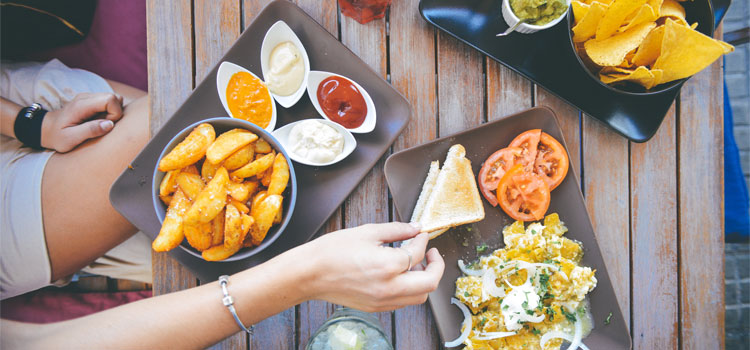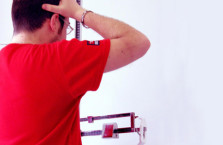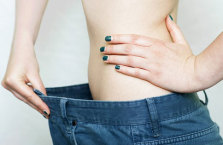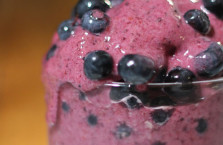I got this great article from Essential Eclectic and can’t wait to share it to you guys. You’ll love this!
I love self-help books.
I have a pile of them littering my bookshelf and I buy them a little obsessively; it’s a problem that itself requires self-help, I’m sure. There is a tiny, silly part of me that feels like reading something about the change I want to make somehow makes me closer to actually making that change. I read about turning some part of my life around, feel satisfied that I’m making moves towards change, and then…that’s it. Not much happens after that. The End.

It’s not often that I set off to make a change–particularly a personal habit change–and actually do it. That is, until earlier this year when I set to get my health under control. I lost almost 10 pounds and inches off my body, in addition to bringing my average blood sugar down significantly and getting my high cholesterol down to normal. Was it a dramatic transformation? Not at all. Did it make a world of difference? Definitely.
However, I will be #totallyhonest and admit that after making this active-living/cleaner-eating lifestyle change for three months, I have sorta fallen off the wagon a little bit (turns out you can get away with using the excuse “hey, it’s my birthday” for a long time–oops!). Regardless, the fact that I was able to be ON the wagon for that long is proof that I am actually capable of making a change, and that I can do it again. And that’s what I needed for myself: Proof.
So now I’m ready to get back on the wagon again. In preparation for that, I put together a list of things I did the first time to jump-start my healthy lifestyle changes, and I thought I would share it with you in case you would like to jump-start with me! Now, of course you don’t have to go about your health journey exactly like I did, and certainly none of these tips are ground-breaking, but I thought I would still share what worked for me in case it might give you some ideas to get started. Shall we?
Tip #1: ACCEPT THE (PROBABLY) INEVITABLE
One thing I always, without fail, do when I try to be healthy is dive head first into a rigorous new eating plan or exercise routine and get burned out trying to do too much too quickly. Towards the end of my three-month healthy streak, I did just that: I was working out an hour a day six days a week, and I couldn’t keep up. What I’m reminding myself this time around is that this is a lifestyle change–there really isn’t any rush! You’ve got the rest of your life to keep going, so it’s okay to take it slow 🙂 If it took you months or years to gain weight, it might take months or years to lose it. Be okay with that. Expect it, even. Or better yet, don’t care! What matters most is how healthy you are; how you look is just a side effect.
Which brings me to my next point…
Tip #2: BABY STEPS

I wouldn’t have been able to survive more than a week of healthy living if I didn’t take baby steps that direction. Gradual change is SO much more sustainable over time, and way less traumatic–both for your body and your mind!
I started out my health journey by simply writing down what I was eating. After doing this for a couple weeks, I then put limits on my calorie intake. I only allowed myself to eat X calories a day (your doctor can help you figure out what X is healthy for you!), but I wasn’t extremely strict about it. As a type 1 diabetic, there are times where I have to eat to raise a low blood sugar, so some days I would go over my calorie limit. Don’t kick yourself if you go over your “limits” (more on this later). And if you’re not even looking to lose weight, you can always set calorie “limits” that promote weight maintenance (or gain, if need be) instead of weight loss.
From there, I realized how much more I could eat during the day if I exercised. Talk about incentive! I slowly added exercise to my routine. As I got stronger, I added more. Start small–very small, if you need to–and work your way up in everything you do!
Tip #3: WRITE IT DOWN

When I first started tracking my food intake, I found the app/website My Fitness Pal to be a great way to keep track of what I was eating. I take my phone everywhere, so having a food tracking app on my phone meant I always had my tracker no more than an arms length away, which was key for me. Plus, it has a cool feature where, if you’re eating packaged food (think yogurt, a cup of juice, etc.), you can scan the barcode on the packaging and the app will automatically upload the food into your tracker, where you can then edit quantities. Pretty spiffy.
For me, tracking my calories was more about making better food choices than the calorie number itself. For example, if I can eat 500 calories for dinner, I would much rather eat a pile of vegetables and protein and feel full than half a cheeseburger and feel hungry. And if I then end up eat 600 calories worth of food? Oh well! At least it was from the broccoli and not the cheeseburger.
Writing down what you eat has been shown to be an effective weight loss promotion tool. It makes you aware of not only what you’re eating, but also how much. Talk about eye opening revelations, people! Even if you’re not actively trying to eat better, you might find yourself trending in that direction anyway–and naturally eating less–simply by writing down the food you put in your mouth. You might also consider writing down when you’re eating and the circumstances surrounding the meal. I didn’t have to track this for long before realizing that I do a lot of mindless munching in front of the TV, and I eat when I’m bored. When you know these things, you can do something about them!
Another thing I wrote down was when I exercised. I printed up a free calendar and put an X over the days I kept up eating well and a W on the days I also worked out. I did this mostly because it felt amazing to look at a calendar full of Xs and Ws! When you see how far you’ve come, it becomes harder to make choices that kill your healthy-living streak!
Lastly, if you’re looking to “lose weight” as part of your healthy lifestyle journey, I would also encourage you to take your measurements before you start making changes. Measure the circumference of your waist, thighs, calves, arms, neck–whatever areas you’re hoping to slim down. This was helpful for me a few weeks in to eating better. I was more concerned about gaining muscle and losing fat, and since muscle weighs more than fat, I noticed that for weeks–despite my hard work–the scale wouldn’t budge. However, I saw results when I looked at my measurements instead: Losing an inch around my tummy meant I was indeed losing fat, even though my scale suggested otherwise. And that was motivating!
Tip #4: PLAN IT OUT

While normally I love planning and organizing (I would plan my wedding over again in a heartbeat!), when it comes to meals and groceries, planning is not something I particularly enjoy. I hate meal planning. I really do. With a vengeance. In addition to tracking my food, exercise, and calories, as a type 1 diabetic I also have to track my carb intake (since carb quantities determine how much insulin I need to give myself) and manage the beast that is my blood sugar (which is a part-time job in itself–can I get an Amen from any type 1s out there?). Needless to say, I wasn’t super interested in adding hardcore meal planning to my list of things to worry about.
This time around I plan on using eMeals, which is an affordable solution for those of us (read: most people) who loathe meal planning. They send you a meal plan each week that includes a printable grocery list. The meals aren’t too complex but are super tasty, and they have 15 different types of meal plans (including clean eating, diabetic, paleo, gluten-free, and vegetarian plans) that can be customized to fit your family size. I signed up recently and so far I’m loving it! I’ll probably do a more detailed review later, but in the meantime you can check out their awesomesauce here:
If meal planning of any kind just isn’t for you, that’s ok. One thing you can do is simply stop buying junk! I have a soft spot in my heart for “kid foods” — frozen pizza, mac n cheese, ramen, pillsbury cinnamon rolls, those kinds of things. But instead of loading my grocery cart with these things like I used to, I started piling in veggies and researching interesting ways to cook them. It’s not a perfect system, but it’s a start. I also found that prepping/portioning out my meats and veggies helped make cooking a ton easier!
Tip #5: MAKE IT DOABLE

Even though we’ve already established that being healthy/exercising is ideally a permanent change, I found that it really helped me to commit to doing an exercise program with a specific time frame. The program I originally chose was 6 weeks, and committing to those 6 weeks was a lot easier for me to swallow than my alternative: forever. Now that I’ve finished the program, I’ve invested in some Jillian Michaels DVDs to carry me for a few months. I get bored doing the same routine every day, so I purchased her 30 Day Shred, Banish Fat, Boost Metabolism, 6 Week Six-Pack, Yoga Meltdown, and No More Trouble Zones DVDs. They were inexpensive (some are free online!) and it would be easy to swap out DVDs each day I exercise to keep things interesting.
Exercise DVDs are doable for me: After purchasing two largely-unused gym memberships, I realized I hate physically going to the gym, and I hate the treadmill waiting for me there even more. If treadmills or DVDs aren’t for you, you might try classes of some kind. I started doing a Zumba class once a week with friends, and 500 calories later it didn’t even feel like exercise! Find something physical that’s fun and that you realistically will have time to do and go for it!
Tip #6: ROOM TO WIGGLE
It’s okay to eat “bad” foods in moderation. The operative word there, however, is moderation. I decided to completely cut out pizza, french fries, pasta dishes (especially with cream sauces) and hamburgers from my diet because regardless of portion size they wreak absolute havoc on my blood sugar, but there are other treats I’ll still occasionally indulge in. And they come in the form of 100 calorie packs! I love these things! Nabisco, Keebler, and Kelloggs (to name a few) make 100 calorie packs of a bunch of stuff. Klondike also makes a pretty mean 100 calorie klondike bar. The key to 100 calorie packs, however, is not eating 7 in a row 😉 Like I mentioned before, counting your calories will help with keeping “bad” food in moderation. When I feel limited in my food choices I go nuts, so these little treats are my pressure valves. What are your pressure valves?
Tip #7: POSITIVE REINFORCEMENT

If you’re like me and need serious motivation to get off the couch, positive reinforcement is possibly one of the most powerful behavior modification tools you could use. If you’re not familiar with the term, the idea is that to encourage a behavior you should reward that behavior when it happens.
Sadly for me, I (and a lot of “dieters”) find food to be very positively reinforcing. “If I run on the treadmill today, I can have a scoop of ice-cream tonight.” I would run for that! Unfortunately, that ice-cream defeats the purpose of the exercise, so that’s no good. Different people find different things positively reinforcing, so take some time to figure out what works for you, and make sure your positive reinforcer isn’t food and is something you actually care about. If gold stars don’t make your heart pitter patter like they did in elementary school, pick another reinforcer. The last time around, I didn’t take advantage of this principle nearly enough. This time, there’s a new camera I’ve had my eye on. 😉 Eventually, you won’t need ice-cream, gold stars or cameras to get you moving–the endorphins will be enough!













